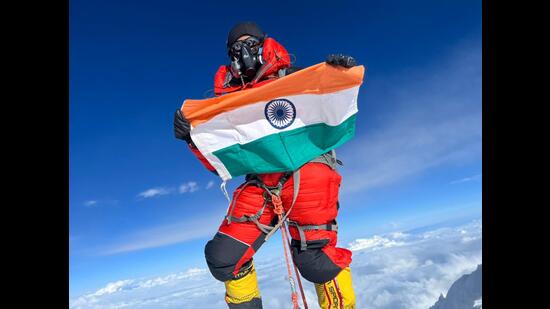Priyanka Mohite is on a Zoom call from Kathmandu, her face glowing, her voice clear and joyful. The phone camera cannot show either her size or her strength, nor how one renders the other irrelevant.
After scaling her fifth 8000er this month, the first Indian woman to do so, Mohite wanted to rush back to Nepal’s capital to meet her anxious parents. The helicopter pilot at the Kanchenjunga base camp accommodated her on the flight to Lukla as the usually unfeasible third passenger — her 48kgs meant that the chopper was well inside the weight limit for lift-off. A few kgs more and it would have taken four more days to reach Kathmandu.
Mountaineering is dominated by tall and lean or square and muscular body types. Mohite, 29, at 5ft and 48kgs, has a gymnast’s dimensions. Yet, around Himalayan campsites, she is one of them, hat-tipped for being a “tagda” (strong, tough) climber.
The 8000ers are peaks above 8,000 metres, 14 of them spread across the Himalaya and Karakoram ranges, the gold standard for mountaineering. Above 8,000 metres, climbers function in the “death zone”, without the requisite oxygen to sustain life. Fewer than 50 climbers have completed the full set. Given that five 8000ers are in Pakistan and two in Tibet, no Indian has scaled all 14. Arjun Vajpai, with six, has the highest tally.

To grasp the allure of the 8000ers, let’s abandon number-crunching and ask the climber why. Mohite was drawn to them when, aged 21, she summited Mount Everest on her first major Himalayan expedition, in 2013. She had come a long way from weekend treks to the Ajinkyatara fort outside her hometown Satara or being group leader at the Sahyadri Trekking Association.
Her love for climbing had to be balanced with the demands of study, Mohite completing her MSc in biotechnology alongside advanced courses in Uttarakhand’s mountaineering institutes. Then, at the top of the world at 21, her mind asked tetchily, “Now what”?
“I didn’t want to just have the ‘Everester’ tag on me. I wanted to be a good climber,” Mohite says. In 2014, she heard of Indian woman climber Chanda Gayan’s death on Kanchenjunga after summiting Everest and Lhotse. “She had climbed two 8000ers and that became inspirational for me,” Mohite says.
***
After 20 hours of the toughest climb of her life, on May 5, Mohite summited Kanchenjunga. In a grim reminder of the risks, her team passed a climber’s body on the route, from who knows how many years ago. “Kanchenjunga is a very technical mountain, very unpredictable. My aim is always not only to reach the top but to return safely. On the summit, you’re in a happy mood and you can be careless. While descending you have to be very, very focused.”
In between Everest and Kanchenjunga, Mohite has lived a life of success, frostbite and fear.
In 2015, she was at the Everest Base Camp, planning to scale Lhotse, when the Nepal earthquake triggered a Himalayan avalanche. When the ground shook, she rushed out of her dining tent. “Then we saw the avalanche. You could hear the rocks coming but the snow made no noise. It just came at us, so fast,” Mohite says.
She came away without a scratch, but across the mountains, 22 people died. It would be three months before she attempted another peak. “I wanted to check if I had it in me to go up a mountain again. If I still wanted this.” Menthosa (6,440 m), the second-highest peak in Lahaul-Spiti, answered her question.
In 2018, she summited Mt Lhotse (8,516 m), Mt Makalu (8,481 m) in 2019, and in 2021, she became the first Indian woman to summit Annapurna (8,091 m), considered the most dangerous of the 8000ers, taking the life of one in every four climbers. Annapurna left Mohite with second-degree frostbite and no climbing for a year.
***
Mohite is based in Bengaluru, a senior researcher at the biotech company Aurigene, experiencing extreme ends of the earth’s dazzling scale. At her day job, she tangles with cancer cells, lab readings and research papers. The mountains are “always there, in my head. They call to me,” she says.
She tries to stay active, always thinking of her next climb. A 15-kg backpack forms part of all training, whether it’s climbing 1,000 steps or walking the highest gym treadmill incline for 90 minutes. Exercise, food, sleep, emailing sponsors, everything is about preparing to meet the mountains again.
“Normally, I’m not a person who is calm, I’m here, there, everywhere… hyper,” she laughs. “In the mountains, I feel very peaceful. They are like a temple where I find happiness, where I want to be a pure form of myself.” When she’s climbing, Mohite says, there are no nerves, no mental clutter. “My mind and my heart are calm and focused.”
So every time she reaches a summit, she reaches down, touches the icy earth and brings her hand to her heart in a gesture of worship and gratitude. “I am no one to decide that I can climb a mountain. She is the one who decides,” she says. “So I touch the summit and say thank you. And ask her to watch over me on the descent.”
Enjoy unlimited digital access with HT Premium
Subscribe Now to continue reading

Stay connected with us on social media platform for instant update click here to join our Twitter, & Facebook
We are now on Telegram. Click here to join our channel (@TechiUpdate) and stay updated with the latest Technology headlines.
For all the latest Art-Culture News Click Here
